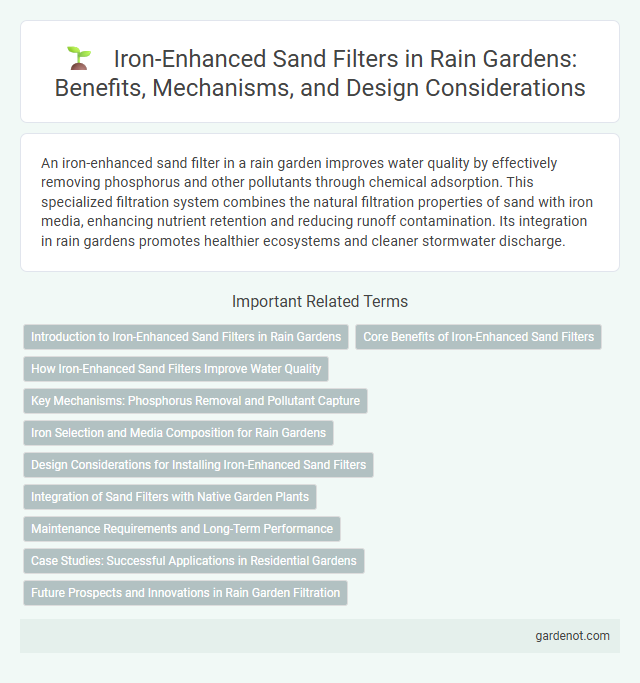An iron-enhanced sand filter in a rain garden improves water quality by effectively removing phosphorus and other pollutants through chemical adsorption. This specialized filtration system combines the natural filtration properties of sand with iron media, enhancing nutrient retention and reducing runoff contamination. Its integration in rain gardens promotes healthier ecosystems and cleaner stormwater discharge.
Introduction to Iron-Enhanced Sand Filters in Rain Gardens
Iron-enhanced sand filters in rain gardens use iron-coated sand to improve the removal of phosphorus and heavy metals from stormwater runoff, enhancing water quality and reducing nutrient pollution. These filters leverage adsorption and chemical reactions between iron particles and contaminants, making them effective for urban and suburban water management. Implementing iron-enhanced sand filters supports sustainable stormwater treatment by promoting infiltration and reducing the risk of eutrophication in nearby water bodies.
Core Benefits of Iron-Enhanced Sand Filters
Iron-enhanced sand filters effectively remove phosphorus and heavy metals from stormwater runoff, significantly reducing water pollution and eutrophication risks. These filters promote enhanced adsorption and precipitation processes, improving overall water quality in urban and agricultural landscapes. Their low maintenance requirements and long operational lifespan make them a sustainable solution for managing nutrient loads and protecting aquatic ecosystems.
How Iron-Enhanced Sand Filters Improve Water Quality
Iron-enhanced sand filters improve water quality by effectively removing phosphorus through chemical adsorption and precipitation processes, significantly reducing nutrient levels that cause eutrophication in stormwater runoff. These filters incorporate iron oxide-coated sand, which binds dissolved phosphorus, preventing its release into surrounding water bodies and enhancing overall water clarity. Their integration in rain gardens supports healthier aquatic ecosystems by mitigating nutrient pollution and promoting sustainable stormwater management.
Key Mechanisms: Phosphorus Removal and Pollutant Capture
Iron-enhanced sand filters effectively remove phosphorus through adsorption and precipitation processes, where iron compounds bind with soluble phosphorus to form insoluble particles. These filters also capture pollutants such as heavy metals and organic contaminants by trapping them in the porous sand matrix enhanced with reactive iron minerals. The combined mechanisms significantly reduce nutrient runoff and improve stormwater quality in rain garden systems.
Iron Selection and Media Composition for Rain Gardens
Iron-enhanced sand filters in rain gardens optimize nutrient removal by selecting iron types such as ferric hydroxide or zero-valent iron, which effectively adsorb phosphorus and heavy metals. Media composition typically combines iron oxide-coated sand with organic material to enhance microbial activity and maximize pollutant retention. Proper grading and particle size distribution within the filter media ensure adequate permeability and prolonged contact time for improved treatment performance.
Design Considerations for Installing Iron-Enhanced Sand Filters
Iron-enhanced sand filters require careful design considerations including proper sizing to accommodate site-specific stormwater flow rates, with media composed of sand blended with iron filings or zero-valent iron to optimize phosphorus adsorption. The filter bed must maintain sufficient hydraulic conductivity while ensuring contact time for effective nutrient removal, typically requiring a filter depth of 0.6 to 1 meter and a hydraulic loading rate between 2 to 10 cm/hr. Selecting corrosion-resistant materials and incorporating overflow mechanisms are critical to prevent system clogging and ensure durability in varying environmental conditions.
Integration of Sand Filters with Native Garden Plants
Iron-enhanced sand filters improve water quality by removing phosphorus and heavy metals through adsorption and precipitation processes. Integrating these filters with native garden plants enhances pollutant uptake while supporting local biodiversity and reducing maintenance needs. Native species such as carex, sedges, and rushes thrive in moist conditions created by the filters, promoting healthy soil microbial activity and long-term filtration efficiency.
Maintenance Requirements and Long-Term Performance
Iron-enhanced sand filters in rain gardens require periodic inspection to monitor iron precipitation build-up and prevent clogging, typically necessitating maintenance every 1 to 3 years depending on inflow water quality. Long-term performance remains effective when iron media is properly aged and replaced every 10 to 15 years, ensuring sustained removal of phosphorus and other pollutants from stormwater. Routine flushing and media rejuvenation techniques enhance permeability and extend filter lifespan, maintaining optimal nutrient retention and hydraulic function.
Case Studies: Successful Applications in Residential Gardens
Iron-enhanced sand filters have demonstrated significant effectiveness in residential rain gardens, reducing phosphorus runoff by up to 90% in multiple case studies across suburban areas in the Midwest United States. These filters leverage iron's affinity for phosphate, promoting nutrient retention and preventing eutrophication in nearby water bodies. Homeowners incorporating iron-enhanced sand filters report improved water quality and healthier plant growth, validating their role in sustainable urban stormwater management.
Future Prospects and Innovations in Rain Garden Filtration
Iron-enhanced sand filters in rain gardens promise significant advancements in phosphorus removal efficiency, addressing urban stormwater pollution more sustainably. Emerging nanomaterial coatings and biochar integrations aim to boost contaminant adsorption capacity and filter longevity. Future innovations will likely incorporate smart sensor technologies for real-time monitoring and adaptive management of filtration performance in diverse environmental conditions.
Iron-enhanced sand filter Infographic

 gardenot.com
gardenot.com